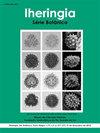Morphological, ecological and toxicological aspects of Raphidiopsis raciborskii (Cyanobacteria) in a eutrophic urban subtropical lake in southern Brazil
IF 0.4
4区 生物学
Q4 Agricultural and Biological Sciences
引用次数: 5
Abstract
A dense perennial bloom of Raphidiopsis raciborskii was observed in an urban lake (29°53’13”S and 51°09’29.9”W). Due to supposed toxicity, this study analyzed the morphology of the species, evaluated the main factors that influence its growth, and examined bloom toxicity. Two sites were sampled monthly from November 2009 to November 2010. The species was found in all samples and dominated in 77% of the samples. Highest density was recorded at the end of summer (March – 199,550 ind.mL-1) at 26.6 oC and pH 7.8. High densities were also found at low temperatures (72,145 ind.mL-1 at 12.6 °C and 130,475 ind.mL-1 at 14.5 °C) and at minimum (5.4) and maximum (8.7) pH, reaching 89,964 ind.mL-1 and 61,400 ind.mL-1, respectively. Nitrogen availability was high, especially ammonium [(60-)140-660 μg.L-1], and phosphorus was low (orthophosphate < 10 μg.L-1). These results support that R. raciborskii has a wide tolerance to abiotic variations. Saxitoxins and gonyautoxins were found in the bloom巴西南部亚热带城市富营养化湖泊中raciborskii蓝藻的形态、生态和毒理学研究
在南纬29°53′13”、西经51°09′29.9”的城市湖泊中,观察到长年生Raphidiopsis raciborskii的密集开花。由于假定的毒性,本研究分析了该物种的形态,评估了影响其生长的主要因素,并检查了华毒性。2009年11月至2010年11月,每月对两个站点进行采样。在所有样本中均有发现,占77%的优势种。夏末(3月- 199,550 ind.mL-1)密度最高,温度26.6℃,pH值7.8。在低温(12.6°C时72,145 ind.mL-1, 14.5°C时130,475 ind.mL-1)和最小(5.4)和最大(8.7)pH下也发现了高密度,分别达到89,964 ind.mL-1和61,400 ind.mL-1。氮有效度高,特别是铵[(60-)140-660 μg]。磷含量较低(正磷酸盐< 10 μg.L-1)。这些结果支持了瑞香鼠对非生物变异具有广泛的耐受性。在藻华中发现了蛤蚌毒素和性腺毒素
本文章由计算机程序翻译,如有差异,请以英文原文为准。
求助全文
约1分钟内获得全文
求助全文
来源期刊

Iheringia Serie Botanica
PLANT SCIENCES-
CiteScore
0.70
自引率
0.00%
发文量
22
审稿时长
>12 weeks
期刊介绍:
The Iheringia, Série Botânica is a publication edited by the Museu de Ciências Naturais, Fundação Zoobotânica do Rio Grande do Sul, since 1958. The name Iheringia is actually a tribute to Hermann von Ihering (a German researcher who became a Brazilian citizen) and his important studies in the Natural Sciences.The journal has the mission of publishing articles, reviews and original scientific notes that cover diverse areas in Botany, and may be written in Portuguese, Spanish and English.
The journal is widely available in both international and national scientific community. The issues are published and distributed twice a year to 118 national institutions and 152 international institutions. The distribution is either free of charge or by exchange.
Impac Factor JCR 2014/2015 = 0.263
Qualis CAPES 2015: B 4 (Biodiversity) B1 (Agricultural Science I) B1 (Environment)
 求助内容:
求助内容: 应助结果提醒方式:
应助结果提醒方式:


